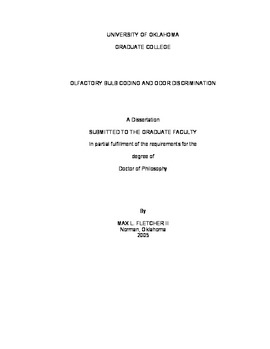| dc.contributor.advisor | Wilson, Donald A., | en_US |
| dc.contributor.author | Fletcher, Max L., Ii. | en_US |
| dc.date.accessioned | 2013-08-16T12:19:50Z | |
| dc.date.available | 2013-08-16T12:19:50Z | |
| dc.date.issued | 2005 | en_US |
| dc.identifier.uri | https://hdl.handle.net/11244/886 | |
| dc.description.abstract | Olfactory system second-order neurons, mitral-tufted cells, have odorant receptive fields (ORFs) (molecular receptive ranges in odorant space for carbon chain length in organic odorant molecules). This study quantified several dimensions of these excitatory odorant receptive fields to novel odorants in rats and then examined the effects of passive odorant exposure on the shape of the ORF-tuning curve. ORFs for carbon chain length of novel ethyl esters (pure odorants that the animals had not been exposed to previously) were determined before and after a 50 sec prolonged exposure to one of the odorants. In response to novel odorants, quantitative analysis of mitral-tufted cell excitatory ORFs revealed that the median ORF width spanned 3--4 carbons, generally with a single-most excitatory odorant. Exposure to either the most excitatory odorant (ON-PEAK) or an odorant that was two carbons longer (OFF-PEAK) for 50 sec produced whole ORF suppression immediately after the end of the prolonged exposure, with the ON-PEAK exposure producing the greatest suppression. These results are consistent with a feature-detecting function for mitral-tufted cells. Redetermination of the ORF 15 and 60 min after the exposure revealed that OFF-PEAK exposure produced a reduction in responsiveness to the best odorant and an increase in responsiveness to the exposed odorant. In contrast, exposure to the ON-PEAK odorant or no odorant did not affect ORFs. Given that mitral-tufted cells receive exclusively excitatory input from olfactory receptor neurons expressing identical receptor proteins, it is hypothesized that experience-induced mitral-tufted cell ORF changes reflect modulation of lateral and centrifugal olfactory bulb circuits. | en_US |
| dc.format.extent | v, 126 leaves : | en_US |
| dc.subject | Odors. | en_US |
| dc.subject | Biology, Neuroscience. | en_US |
| dc.subject | Smell. | en_US |
| dc.subject | Olfactory nerve. | en_US |
| dc.title | Olfactory bulb coding and odor discrimination. | en_US |
| dc.type | Thesis | en_US |
| dc.thesis.degree | Ph.D. | en_US |
| dc.thesis.degreeDiscipline | Department of Biology | en_US |
| dc.note | Adviser: Donald A. Wilson. | en_US |
| dc.note | Source: Dissertation Abstracts International, Volume: 66-05, Section: B, page: 2439. | en_US |
| ou.identifier | (UMI)AAI3174274 | en_US |
| ou.group | College of Arts and Sciences::Department of Biology | |
